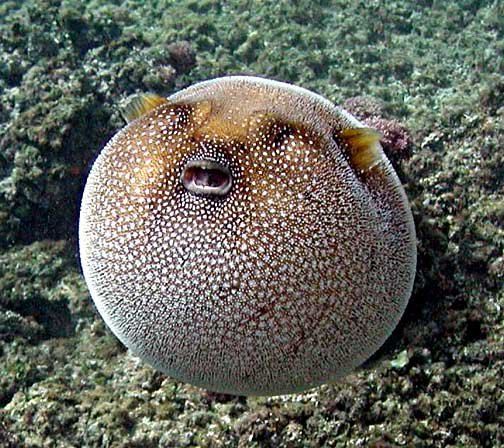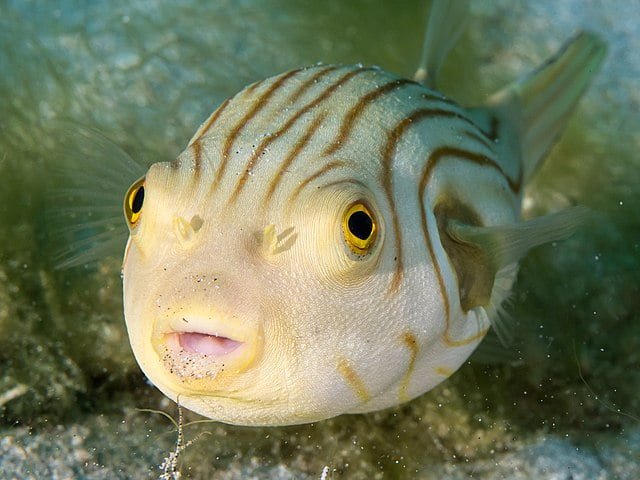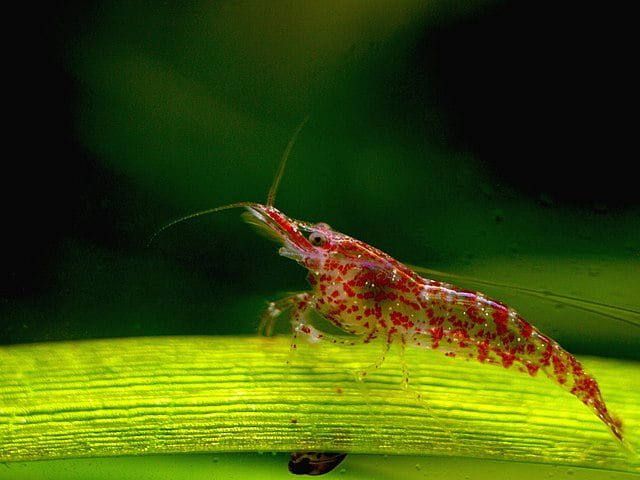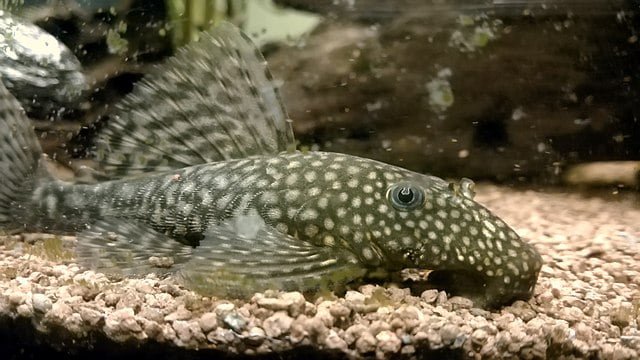
Pufferfish are one of the most fascinating creatures in the ocean. These friendly and eccentric fish are known for their ability to inflate into a ball shape and their unique defense mechanism, which involves producing toxic chemicals.
Although they may seem harmless, globefish are actually one of the deadliest creatures in the sea, as some species contain enough poison to kill several humans.
Despite their deadly reputation, puffers have become increasingly popular in the aquarium trade and as a delicacy in certain cuisines. Some species of balloonfish, such as Takifugu, are famous for their delicious taste (Zhang et al., 2019).
In this article, we will explore the fascinating world of pufferfish, from their physical characteristics and behavior to their role in various cultures and cuisines. Get ready to dive into the wonderful and intriguing world of pufferfish.
Types and taxonomy of pufferfish
- 1 Types and taxonomy of pufferfish
- 2 Physical characteristics of puffers
- 3 Habitat and distribution of globefish
- 4 Feeding of puffers fish
- 5 Reproduction and life cycle of globefish
- 6 Venomous Pufferfish and their Toxicity
- 7 Culinary use of Puffer
- 8 Pufferfish in Popular Culture and Mythology
- 9 Conservation Status of Puffer
- 10 Breeding of Pufferfish
- 11 Conclusion
- 12 References
- 13 Entradas relacionadas:
Pufferfish belong to the family Tetraodontidae (four teeth) and are found in tropical and temperate waters worldwide. There are more than 197 species of globefish grouped into 28 genera.
The size of pufferfish varies, ranging from 2.5 centimeters in length for the dwarf pufferfish (Carinotetraodon travancoricus) to 61 centimeters for the giant freshwater pufferfish (Tetraodon mbu) and the starry pufferfish (Arothron stellatus) which can reach up to 1.20 meters.
Kingdom: Animalia
Stay Always Informed
Join our communities to instantly receive the most important news, reports, and analysis from the aquaculture industry.
Phylum: Chordata
Subphylum: Vertebrata
Class: Actinopterygii
Subclass: Neopterygii
Infraclass: Teleostei
Superorder: Acanthopterygii
Order: Tetraodontiformes
Family: Tetraodontidae
Common name: Pufferfish
Common name in English: Pufferfish, puffers, globefish, balloonfish, blowfish, swellfish.
Some of the most common species include the bulging-eyed puffers, the green-spotted globefish, and the saddle balloonfish.
The bulging-eyed pufferfish, as the name suggests, has large and prominent eyes that allow it to see clearly in murky waters.
The green-spotted puffers, on the other hand, has bright green spots on its body that make it easily recognizable.
The saddle pufferfish is known for its distinctive saddle-like shape on its back.
Physical characteristics of puffers
Blowfish have a number of distinctive physical characteristics that set them apart from other creatures of the sea. In addition to their ability to inflate into a ball, they have a rounded body and a large, wide head.
They have tough, spiky skin that protects them from predators, and their fins are small and barely visible.
Puffers also have sharp teeth that enable them to tear flesh.

Habitat and distribution of globefish
Pufferfish are found in tropical and temperate waters worldwide. They can be found in coral reefs, shallow waters, and the ocean floor down to a depth of 300 meters. Some puffers prefer to live in warmer waters, while others prefer colder waters.
Most species of globefish are found in marine waters, however, some species live in freshwater and brackish water. Approximately 37 species of pufferfish spend their entire lives in freshwater, and 48 species are distributed in brackish waters (Santhanam, 2017).
Blowfish are solitary creatures, but some species can form groups and swim together.
Feeding of puffers fish
The diet of globefish varies depending on the species and the habitat they inhabit. Some species of puffers feed on algae and plankton, while others eat crustaceans, mollusks, and other fish.
Balloonfish have a unique digestive system that allows them to consume very hard and difficult-to-digest foods. They also have a very strong jaw that enables them to crush and tear flesh.
In the past decade, feeds have been developed to feed blowfish raised in aquaculture systems or aquariums.
Cheng et al., (2018) report that diets supplemented with 80-320 mg/kg of astaxanthin for Takifugu obscurus pufferfish can enhance growth, non-specific immune responses, and improve resistance to high-temperature stress.
Reproduction and life cycle of globefish
The reproduction of pufferfish varies depending on the species. Tetraodontidae are oviparous animals.
Male puffers construct nests that have a circular shape, and when the female visits the nest, the male courts her until the female pufferfish spawns.
Female globefish release between 3 and 7 eggs. The eggs float on the water’s surface until they hatch within a week.
Newly hatched puffers larvae are very small and vulnerable, and they must face many dangers in the ocean, including predators and strong currents. In this regard, the mother’s tetrodotoxin (TTX) plays an important role in protecting the larvae of Takifugu alboplumbeus pufferfish from predators (Itoi et al., 2018).
Venomous Pufferfish and their Toxicity
While globefish are known for their ability to inflate into a ball, their most effective defense mechanism is their ability to produce toxic chemicals.
Some species of puffers contain tetrodotoxin (TTX), a highly toxic chemical that is lethal to humans and other animals. Tetrodotoxin is up to 1,200 times more poisonous than cyanide, and a single globefish contains enough tetrodotoxin to kill 30 adult humans, with no known antidote.
Tetrodotoxin is a neurotoxin that blocks sodium channels on the surface of nerve membranes. This toxin is primarily found in the viscera (liver, ovaries, testes) of many pufferfish species.
Okabe et al. (2019) determined that the toxic flatworm Planocera multitentaculata may be the source of tetrodotoxin in the globefish T. alboplumbeus (formerly T. niphobles). Zhang et al. (2020) investigated the accumulation, elimination, and distribution of TTX in pufferfish T. obscurus fed with the gastropod Nassarius semiplicata, which contains tetrodotoxin, and determined its accumulation in the skin and liver of the pufferfish.
Other studies determine the presence of tetrodotoxin in bivalves as a consequence of the consumption of cyanobacteria.
The Japan Food Hygiene Association has established that pufferfish meat exceeding the regulatory limit of 2 µg/g of TTX is not considered safe for human consumption (Santhanam, 2017).
Culinary use of Puffer
Despite their toxicity, globefish are considered a delicacy in Japan, China, and Korea, and they have been farmed since the 1960s, establishing a significant pufferfish aquaculture industry in East Asia (Gao et al., 2014).
In Japan, for example, fugu, a variety of pufferfish, is served and can only be prepared by specialized chefs who have been trained to avoid the most toxic parts of the fish.
However, it appears that farming pufferfish eliminates the risk of toxicity in two edible puffers species: T. obscurus and T. rubripes.
One of the main concerns is the mislabeling of globefish, which has led to a series of intoxications. In this regard, Kim and Kang (2023) developed a combined method for the identification and authentication of 73 commercial pufferfish products.
On the other hand, Li et al. (2020) studied the use of chitosan and sodium alginate on the quality of cultured Takifugu obscurus globefish during cold storage and concluded that coatings containing both compounds maintain the quality of pufferfish meat at 4°C.
Pufferfish in Popular Culture and Mythology
Blowfish have played an important role in many cultures and mythologies around the world.
In Japan, the pufferfish is a symbol of good luck and happiness, and its round shape and ability to inflate into a ball are believed to represent abundance and prosperity.
In Hawaiian culture, the puffers is considered a symbol of protection and is believed to have the power to ward off evil spirits.
Conservation Status of Puffer
Some species of globefish are endangered due to habitat loss, pollution, and overfishing. Fortunately, efforts are underway to protect and conserve these fascinating creatures.
According to Santhanam (2017), out of the 197 recorded pufferfish species, information on their conservation status is only available for a few species.
In some countries, protected areas have been established to safeguard blowfish and their habitats, and measures have been implemented to regulate pufferfish fishing and trade.
Breeding of Pufferfish
Pufferfish Aquaculture
The three edible species of pufferfish that are being bred in aquaculture systems are Takifugu obscurus, T. flavidus, and the “tiger pufferfish” T. rubripes. The aquaculture of these species is primarily developed in China.
Wang et al. (2016) studied the cultivation of T. rubripes pufferfish in two farming systems: open-air system and recirculating aquaculture system (RAS), and they concluded that RAS cultivation showed better production indicators. Due to the high cost of male pufferfish gonads, it could promote monosex cultivation.
On the other hand, Kim et al. (2016) investigated the effects of light spectrum and determined that Takifugu rubripes globefish raised under green light showed higher weight gain and feed efficiency.
One of the main issues in rearing juvenile “tiger pufferfish” T. rubripes is cannibalization caused by inappropriate feeding regimes. In this regard, Gao et al. (2023) recommend feeding globefish juveniles four times a day.

Aquarium Breeding
Pufferfish have become increasingly popular in the aquarium trade, and many people enjoy having these fish as pets. However, it is important to remember that pufferfish can be dangerous and require careful attention and care.
Globefish need a large and well-equipped aquarium with clean and filtered water, as well as a proper diet.
It is also important to note that some puffers species can be aggressive towards other fish in the aquarium, so it is crucial to choose tank mates carefully.
Pufferfish species that can be bred in aquariums include Arothron firmamentum, A. hispidus, A. inconditus, A. mappa, A. meleagris, A. nigropunctatus, among others. A more detailed description of the specific needs of each species can be found in Santhanam’s publication (2017).

Conclusion
Pufferfish are one of the most fascinating creatures in the ocean, with their unique ability to inflate into a ball and produce toxic chemicals.
Despite their deadly reputation, these fish are appreciated for their beauty and uniqueness, and they have played an important role in many cultures and mythologies around the world.
If you have the opportunity to see a globefish in the wild or in an aquarium, take the time to appreciate its beauty and uniqueness.
References
Cheng, CH., Guo, ZX., Ye, CX. et al. Effect of dietary astaxanthin on the growth performance, non-specific immunity, and antioxidant capacity of pufferfish (Takifugu obscurus) under high temperature stress. Fish Physiol Biochem 44, 209–218 (2018). https://doi.org/10.1007/s10695-017-0425-5
Gao, Y., Gao, Q., Zhang, H., Wang, L., Zhang, F., Yang, C., & Song, L. (2014). Draft sequencing and analysis of the genome of pufferfish Takifugu flavidus. DNA research, 21(6), 627-637.
Gao, X. Q., Wang, X., Wang, X. Y., Li, H. X., Xu, L., Huang, B., … & Liu, B. L. (2022). Effects of different feeding frequencies on the growth, plasma biochemical parameters, stress status, and gastric evacuation of juvenile tiger puffer fish (Takifugu rubripes). Aquaculture, 548, 737718.
Itoi, S., Suzuki, M., Asahina, K., Sawayama, E., Nishikubo, J., Oyama, H., … & Sugita, H. (2018). Role of maternal tetrodotoxin in survival of larval pufferfish. Toxicon, 148, 95-100.
Kim, B. H., Hur, S. P., Hur, S. W., Lee, C. H., & Lee, Y. D. (2016). Relevance of light spectra to growth of the rearing tiger puffer Takifugu rubripes. Development & Reproduction, 20(1), 23.
Kim, K. H., & Kang, T. S. (2023). A systematic approach for pufferfish identification at the species level using DNA-based methods. Food Control, 147, 109574.
Li, P., Zhou, Q., Chu, Y., Lan, W., Mei, J., & Xie, J. (2020). Effects of chitosan and sodium alginate active coatings containing e-polysine on qualities of cultured pufferfish (Takifugu obscurus) during cold storage. International journal of biological macromolecules, 160, 418-428.
Okabe, Taiki, Hikaru Oyama, Maho Kashitani, Yuta Ishimaru, Rei Suo, Haruo Sugita, and Shiro Itoi. 2019. “Toxic Flatworm Egg Plates Serve as a Possible Source of Tetrodotoxin for Pufferfish” Toxins 11, no. 7: 402. https://doi.org/10.3390/toxins11070402
Santhanam, R. (2017). Biology and ecology of toxic pufferfish. CRC Press.
Wang, Q. L., Zhang, H. T., Ren, Y. Q., & Zhou, Q. (2016). Comparison of growth parameters of tiger puffer Takifugu rubripes from two culture systems in China. Aquaculture, 453, 49-53.
Zhang, N., Wang, W., Li, B., & Liu, Y. (2019). Non-volatile taste active compounds and umami evaluation in two aquacultured pufferfish (Takifugu obscurus and Takifugu rubripes). Food Bioscience, 32, 100468.
Zhang, Xiaojun, Jingjing Zong, Si Chen, Menglong Li, Yibo Lu, Ruirui Wang, and Hanxiang Xu. 2020. “Accumulation and Elimination of Tetrodotoxin in the Pufferfish Takifugu obscurus by Dietary Administration of the Wild Toxic Gastropod Nassarius semiplicata” Toxins 12, no. 5: 278. https://doi.org/10.3390/toxins12050278
Editor at the digital magazine AquaHoy. He holds a degree in Aquaculture Biology from the National University of Santa (UNS) and a Master’s degree in Science and Innovation Management from the Polytechnic University of Valencia, with postgraduate diplomas in Business Innovation and Innovation Management. He possesses extensive experience in the aquaculture and fisheries sector, having led the Fisheries Innovation Unit of the National Program for Innovation in Fisheries and Aquaculture (PNIPA). He has served as a senior consultant in technology watch, an innovation project formulator and advisor, and a lecturer at UNS. He is a member of the Peruvian College of Biologists and was recognized by the World Aquaculture Society (WAS) in 2016 for his contribution to aquaculture.




